The abbey of Aiguebelle
 The
abbey Notre-Dame d' Aiguebelle is a French Cistercian abbey located on
the current communes of Montjoyer and Réauville in the department of
Drome.
The
abbey Notre-Dame d' Aiguebelle is a French Cistercian abbey located on
the current communes of Montjoyer and Réauville in the department of
Drome.
 One
preserves, engraved on a rectangular stone of limestone, the text of
foundation of the abbey of Aiguebelle. Thanks to it, we know the name
of the giver, Gontard Loup, lord of Rochefort in Valdaine but also of
the founder abbey, Champagne Morimond, fourth girl of Cîteaux.
One
preserves, engraved on a rectangular stone of limestone, the text of
foundation of the abbey of Aiguebelle. Thanks to it, we know the name
of the giver, Gontard Loup, lord of Rochefort in Valdaine but also of
the founder abbey, Champagne Morimond, fourth girl of Cîteaux.
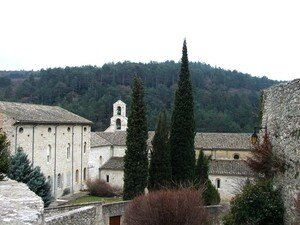 Aiguebelle
was founded the VI of the calends of July 1137, in other words on June
26, 1137, in the honor of the Virgin Mary, with the borders of Dauphiné
and Provence. Left-handed person, abbot of Morimond and former prior of
Saint Bernard in Clairvaux, sent 12 monks under the control of an abbot.
Aiguebelle
was founded the VI of the calends of July 1137, in other words on June
26, 1137, in the honor of the Virgin Mary, with the borders of Dauphiné
and Provence. Left-handed person, abbot of Morimond and former prior of
Saint Bernard in Clairvaux, sent 12 monks under the control of an abbot.
 To
carry out this foundation, Gontard Loup gave a territory, left covered
plate of wood and undergrowth, which one can compare about to the
territory of the commune of Montjoyer with prolongations on the
communes of Roussas and Réauville. The monastery is built in an
insulated small valley, like wanted it the tradition cistercian, with
the confluence of three brooks, Ranc, Flammenche and Vence, from where
the name of “beautiful water”, Aiguebelle.
To
carry out this foundation, Gontard Loup gave a territory, left covered
plate of wood and undergrowth, which one can compare about to the
territory of the commune of Montjoyer with prolongations on the
communes of Roussas and Réauville. The monastery is built in an
insulated small valley, like wanted it the tradition cistercian, with
the confluence of three brooks, Ranc, Flammenche and Vence, from where
the name of “beautiful water”, Aiguebelle.
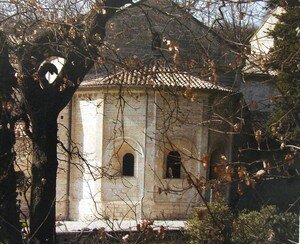 With
the XIIth century, the monastery profits from the donations of the
close lords and increases his field considerably: it has grounds to the
foot of the Mount Gerbier des Joncs, in Dauphiné, in the Orange
Country and in Vivarais.
With
the XIIth century, the monastery profits from the donations of the
close lords and increases his field considerably: it has grounds to the
foot of the Mount Gerbier des Joncs, in Dauphiné, in the Orange
Country and in Vivarais.
Its beautiful prosperity made him make in
its turn foundations: that of the abbey of Feniers, in Auvergne, in
1169, then that of the abbey of Bouchet.
 At the end of the XIIIth century, the Abbey exerted a great radiation on Provence, Dauphiné and Auvergne.
At the end of the XIIIth century, the Abbey exerted a great radiation on Provence, Dauphiné and Auvergne.
From the XIVth century, the tests will multiply: one hundred Year old war, Black Death, falls of the vocations, especially of the brothers convers who maintained the barns and the grounds. The possessions for the majority are given in lease. After 1515, the abbots are not any more elected by the monks but are named by the king: they are the abbots commendataires, external with the monastery and who are thus not worried always needs for their monks nor of the enthusiasm of their community. During the dispersion of the monks in 1791, they are nothing any more but three. The monastery then is plundered then sold like national good. Its distance compared to the transportation routes will save it demolition.
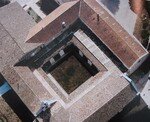 The
absence of the monks will last less than 25 years: in 1815, a group of
cistercians Trappists comes to make revive the monastery. They come
from Switzerland and result from a group of French monks of the abbey
of the Trap door which, under the control of the Father Augustin de
Lestranges, traversed all Europe pursued by the revolutionary armies
and allow the monastic revival and cistercian in France after the fall
of Napoleon.
The
absence of the monks will last less than 25 years: in 1815, a group of
cistercians Trappists comes to make revive the monastery. They come
from Switzerland and result from a group of French monks of the abbey
of the Trap door which, under the control of the Father Augustin de
Lestranges, traversed all Europe pursued by the revolutionary armies
and allow the monastic revival and cistercian in France after the fall
of Napoleon.
 The
abbey preserved, in spite of some demolitions, some restoration and
earthquakes many, most of the medieval conventual buildings: church,
cloister, sacristy, chapter, room of the monks, refectory, kitchen and
all the building of the convers. It is the only cistercian monastery in
France with the abbey of Fontfroide to have still the primitive lane of
the convers.
The
abbey preserved, in spite of some demolitions, some restoration and
earthquakes many, most of the medieval conventual buildings: church,
cloister, sacristy, chapter, room of the monks, refectory, kitchen and
all the building of the convers. It is the only cistercian monastery in
France with the abbey of Fontfroide to have still the primitive lane of
the convers.
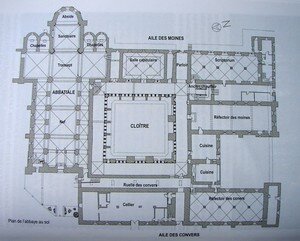 The
church measures 50 m of overall length, 9 m of width in the nave, 17 m
with the collateral ones and 10 m of rise. Regularly directed, it is
established in the north of the cloisters and form a Latin cross made
up of a nave and sides, with a transept on each arm of which two vaults
open.
The
church measures 50 m of overall length, 9 m of width in the nave, 17 m
with the collateral ones and 10 m of rise. Regularly directed, it is
established in the north of the cloisters and form a Latin cross made
up of a nave and sides, with a transept on each arm of which two vaults
open.
 With
its very thick walls, its massive pillars, its Roman arches for the
majority or hardly broken, its ribbed vaults, its rare windows (of
which some were increased), it carries the mark of the transition
style, which characterizes the XIIth century. One notices in the
sanctuary a large arcade which with been able to shelter a tomb
formerly. In the right transept, a staircase led to the old dormitory
of the monks.
With
its very thick walls, its massive pillars, its Roman arches for the
majority or hardly broken, its ribbed vaults, its rare windows (of
which some were increased), it carries the mark of the transition
style, which characterizes the XIIth century. One notices in the
sanctuary a large arcade which with been able to shelter a tomb
formerly. In the right transept, a staircase led to the old dormitory
of the monks.
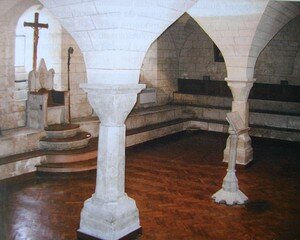 The
chapter, or chapter house, is the conference room of the community. One
reads a chapter of the Rule there (from where the name of capitulum),
whose Superior gives then a comment. The Superiors have their seat with
the East, while the monks line up on the benches of stone laid out in
amphitheatre. It is in this room that the takings the cloth and
professions take place and that are held the important deliberations.
The
chapter, or chapter house, is the conference room of the community. One
reads a chapter of the Rule there (from where the name of capitulum),
whose Superior gives then a comment. The Superiors have their seat with
the East, while the monks line up on the benches of stone laid out in
amphitheatre. It is in this room that the takings the cloth and
professions take place and that are held the important deliberations.
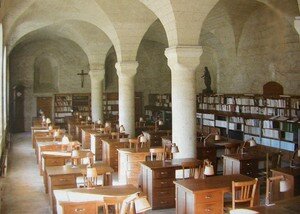 Parallel
with the refectory from which it is separated by an in the open air
court formerly, the large room of the monks opens with the foot of the
large staircase. The groined vaults fall down in the center on four
columns which thus give two lines of five spans. Formerly cellar or
storeroom, it is today the room of reading and studies, the
scriptorium, with long lines of books and offices out of wooden. The
five twinned arcades which exempt the light replaced the three small
primitive windows.
Parallel
with the refectory from which it is separated by an in the open air
court formerly, the large room of the monks opens with the foot of the
large staircase. The groined vaults fall down in the center on four
columns which thus give two lines of five spans. Formerly cellar or
storeroom, it is today the room of reading and studies, the
scriptorium, with long lines of books and offices out of wooden. The
five twinned arcades which exempt the light replaced the three small
primitive windows.
 The
refectory opens on the southernmost gallery of the cloister. It is one
of the rooms best preserved primitive buildings with its vast 25 m
length nave and 8 broad on more than 9 m of rise. Its barrel vault
slightly broken is supported by three arcs beams deadened in conical
bases which seem to return in the wall to 2,60 m below the cornice. The
refectory was formerly enlightened of 12 windows, but several are
currently masked by more recent constructions. A door gives access to
the expenditure (old kitchen) and the current kitchen, which are two
largely arched rooms. The lighting, dissimulated along the cornices,
emphasizes the cradle of the vault of the refectory. It is dated from
the XIIIth century.
The
refectory opens on the southernmost gallery of the cloister. It is one
of the rooms best preserved primitive buildings with its vast 25 m
length nave and 8 broad on more than 9 m of rise. Its barrel vault
slightly broken is supported by three arcs beams deadened in conical
bases which seem to return in the wall to 2,60 m below the cornice. The
refectory was formerly enlightened of 12 windows, but several are
currently masked by more recent constructions. A door gives access to
the expenditure (old kitchen) and the current kitchen, which are two
largely arched rooms. The lighting, dissimulated along the cornices,
emphasizes the cradle of the vault of the refectory. It is dated from
the XIIIth century.
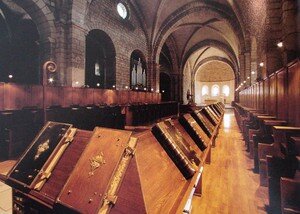 The
room of community or chapter out-cloister was in the past the chapter
and the room of reading of the convers brothers . The vaults and the
columns are with identical those of scriptorium. This room is currently
used for the Community meetings of all kinds: Community chapters,
conferences and retirements.
The
room of community or chapter out-cloister was in the past the chapter
and the room of reading of the convers brothers . The vaults and the
columns are with identical those of scriptorium. This room is currently
used for the Community meetings of all kinds: Community chapters,
conferences and retirements.
The books of the community are divided primarily into three places. With the scriptorium which gathers the most usual books. With armarium where is the recent books. And finally with the large library, much vaster, where a great number of books is stored of which oldest, used for more pointed studies. The whole gathers approximately 90.000 books.
 The
cloister is dated from the XIIth century and includes/understands
four square galleries of 29 side m. The vaults, which show the birth of
the warhead, are supported by surmounted coupled posts of capitals all
different and a large variety from foliages and hooks, but only the
posts of the northern gallery, skirting the church, are primitive. One
reads on several of them graffiti and inscriptions of the XIVth
century.
The
cloister is dated from the XIIth century and includes/understands
four square galleries of 29 side m. The vaults, which show the birth of
the warhead, are supported by surmounted coupled posts of capitals all
different and a large variety from foliages and hooks, but only the
posts of the northern gallery, skirting the church, are primitive. One
reads on several of them graffiti and inscriptions of the XIVth
century.
The other galleries, partly destroyed in 1562, were raised by the Abbot Adrien de Bazemont (1559-1601), but of simple arcades closed by windows replaced the broken posts. With the XIXth century, the abbot Dom Gabriel Monbet made restore the Eastern gallery on the model of the northern gallery and in 1936, Dom Bernard Delauze embedded new posts in the arcades of XVIth century of the two other galleries. These transformations explain the current dissymmetry of the four galleries of the cloister.
 At
the entry of the refectory perhaps a lavatorium as in a number of
abbeys was, but it completely disappeared. A tomb stone discovered at
the entry of the abbey church and which is supposed to be that of the
founder, Gontard Loup, lord of Rochefort, was placed in the
southernmost gallery. An inscription in false Gothic in the Eastern
gallery reproduces the content of the stone of foundation of the abbey
- June 26, 1137 - including one important fragment is preserved at the
Library. Benches, under the northern gallery, make it possible to the
monks to sit down. One notices an old statue out of wooden gilded of
the Virgin who, before the Revolution, was in the church above the
high altar.
At
the entry of the refectory perhaps a lavatorium as in a number of
abbeys was, but it completely disappeared. A tomb stone discovered at
the entry of the abbey church and which is supposed to be that of the
founder, Gontard Loup, lord of Rochefort, was placed in the
southernmost gallery. An inscription in false Gothic in the Eastern
gallery reproduces the content of the stone of foundation of the abbey
- June 26, 1137 - including one important fragment is preserved at the
Library. Benches, under the northern gallery, make it possible to the
monks to sit down. One notices an old statue out of wooden gilded of
the Virgin who, before the Revolution, was in the church above the
high altar.


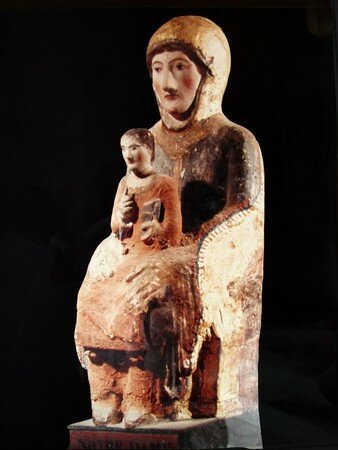 It
should not be forgotten that before the revolution, and since the XIIth century at least, the monks of Aiguebelle venerated a virgin in
majesty, that one of them immured for the period of disorders in order
to protect it. Found following restorations, it was given to the priest
of the Guard-Adhémar. It is at present in the church Saint Michel,
afterwards many tours. See içi.
It
should not be forgotten that before the revolution, and since the XIIth century at least, the monks of Aiguebelle venerated a virgin in
majesty, that one of them immured for the period of disorders in order
to protect it. Found following restorations, it was given to the priest
of the Guard-Adhémar. It is at present in the church Saint Michel,
afterwards many tours. See içi.
 The
site of the abbey includes also a cave, known as Doors. It
occurs in this quelquechose place from magic. A source is channeled,
which says to us that water once again is crowned in this corner of
France.
The
site of the abbey includes also a cave, known as Doors. It
occurs in this quelquechose place from magic. A source is channeled,
which says to us that water once again is crowned in this corner of
France.
Energy is powerful there. Just at side runs the Flammenche river, which proposes to us, along its bed, a regenerating ballade, how much.
I propose a page of pub to you: two articles which I never fail to buy before leaving… Alexion is a drink absolutely éffarante. I knew the father Alexis, his inventor. He was the healer of the area, of the bodies like hearts.
And what I call the “pomade of the monks”, brilliant for osteoarthritides, luxations, bronchitis and even eczema… I have some permanently in my refrigerator!
http://www.abbaye-aiguebelle.com/
http://fr.wikipedia.org/wiki/Abbaye_Notre-Dame_d'Aiguebelle

/https%3A%2F%2Fprofilepics.canalblog.com%2Fprofilepics%2F1%2F1%2F116167.jpg)
/https%3A%2F%2Fstorage.canalblog.com%2F49%2F16%2F312499%2F14620054_o.jpg)
/https%3A%2F%2Fstorage.canalblog.com%2F53%2F18%2F312499%2F14151229_o.jpg)
/https%3A%2F%2Fstorage.canalblog.com%2F07%2F05%2F312499%2F14149867_o.jpg)
/https%3A%2F%2Fstorage.canalblog.com%2F11%2F35%2F312499%2F14149307_o.jpg)
/https%3A%2F%2Fstorage.canalblog.com%2F90%2F14%2F312499%2F14125247_o.jpg)

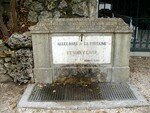
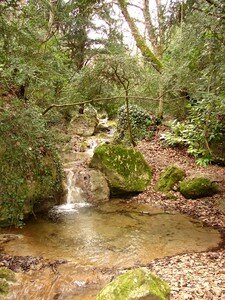


/https%3A%2F%2Fstorage.canalblog.com%2F12%2F98%2F137895%2F6624411_p.jpg)
/https%3A%2F%2Fstorage.canalblog.com%2F34%2F82%2F137895%2F27207854_p.jpg)
/https%3A%2F%2Fstorage.canalblog.com%2F32%2F37%2F137895%2F15872299_p.jpg)
/https%3A%2F%2Fstorage.canalblog.com%2F37%2F81%2F137895%2F15879822_p.jpg)